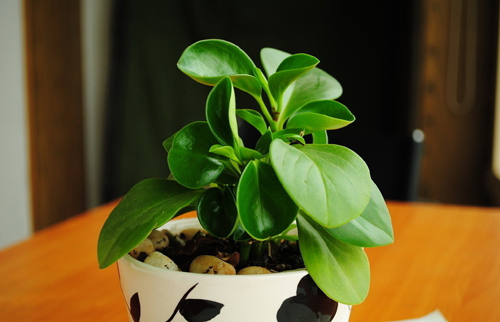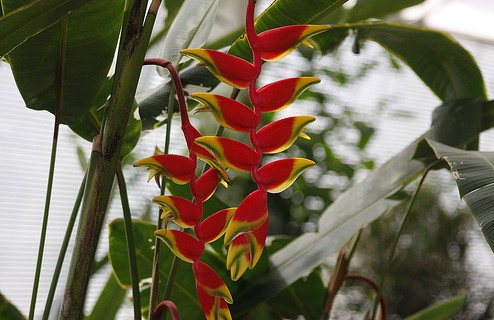How to cultivate Zibian Jasper
Purple edge Jasper, also known as pepper grass, Piperaceae grass pepper, perennial herbs. Native to the West Indies, Panama, northern South America. Like the warm and humid semi-overcast environment. The growth temperature is about 25 degrees Celsius, the lowest can not be lower than 10 degrees Celsius, can not bear high temperature, requires higher air humidity, avoid direct sunlight. Like loose, fertile, well-drained moist soil.
Water: like moist, May to September growth period should be more watering, hot weather should be foliar spray or water, in order to maintain greater air humidity, keep leaves clear patterns and green leaf color.
Fertilizer: fertilize once a month until overwintering.
Soil: the soil that requires loose, fertile and good drainage can be mixed with river sand, mud fabric and rotten leaf soil.
Temperature: like warmth, the suitable temperature for growth is about 25 degrees Celsius, and the overwintering temperature should not be lower than 10 degrees Celsius.
Light: avoid direct sunlight and should grow in semi-shade.
Reproduction: ramet and leaf cuttings. Spring and autumn ramets are propagated. The whole leaf is inserted and propagated from May to June, the leaf is inserted with petiole about 1 cm, inserted to 3 places of the leaf, and the substrate uses river sand, which can take root in 15 days under the condition of 20-25 degrees Celsius. Pay attention to keeping the substrate moist and-constant air humidity.

How to raise purple edge Jasper, the breeding methods and matters needing attention of purple edge Jasper
Purple edge Jasper is native to the West Indies, Panama, northern South America, is an indoor ornamental plant, may know that there are not many flower friends. There are also flower friends who want to know how to raise purple Jasper? This paper introduces the breeding methods and matters needing attention of Zibian Jasper.
Growth habits of purple edge Jasper
Purple edge Jasper likes a warm and humid semi-shady environment. The suitable temperature for growth is about 25 ℃, and the lowest is not less than 10 ℃. It is not resistant to high temperature, requires high air humidity, avoid direct sunlight, and likes moist soil with loose, fertile and good drainage.
Culture method of Zibian Jasper
Water: like moist, May-September growth period should be more watering, hot weather should be foliar spray or water, in order to maintain greater air humidity, keep leaves clear patterns and green leaf color.
Fertilizer: fertilize once a month until overwintering.
Soil: the soil that requires loose, fertile and good drainage can be mixed with river sand, mud fabric and rotten leaf soil.
Temperature: like warmth, the suitable temperature for growth is about 25 ℃, and the overwintering temperature should not be lower than 10 ℃.
Light: avoid direct sunlight and should grow in semi-shade.
Reproduction: ramet and leaf cuttings. Spring and autumn ramets are propagated. From May to June, the whole leaf was inserted, the leaf was inserted with petiole about 1 cm, inserted to 3 places of the leaf, and the substrate used river sand, which could take root in 15 days under the condition of 20-25 ℃. Pay attention to keep the substrate moist and a certain degree of air humidity.
The above is the introduction of the breeding methods and matters needing attention of Zibian Jasper. According to the above method, Zibian Jasper will surely grow up healthily.
How to raise purple edge Jasper grass in pot culture methods and matters needing attention
Purple edge jade pepper grass is a very small and lovely plant, there are many varieties of purple edge jade pepper grass, and the difference between them mainly comes from the change of leaf pattern. So it's very easy to tell. And their breeding methods also have a strong commonness, so if you master a culture skill, you can master the planting methods of the whole class of plants.
How to raise purple edge Jasper pepper grass in pot
Like the warm and humid semi-overcast environment. The suitable temperature for growth is about 25 ℃, the lowest is not less than 10 ℃, and it is not resistant to high temperature. Higher air humidity is required and direct sunlight is avoided. Like loose, fertile, well-drained moist soil.
Culture methods and matters needing attention of Jasper Pepper Grass in Zibian
1. The moisture needed by purple edge Jasper
Purple edge Jasper likes the humid environment, May to September is the growing period, the growing period should be more watering, when the weather is hot, the leaf should be sprayed or drenched, in order to maintain a large air humidity, keep the leaf clear pattern and green leaf color.
2. Fertilizer needed by Zibian Jasper
Fertilize once a month until overwintering.
3. The soil needed by Zibian Jasper
The soil requiring loose, fertile and good drainage can be mixed with river sand, mud fabric and rotten leaf soil.
4. The temperature needed by the purple edge Jasper
Like warmth, the suitable growth temperature is about 25 ℃, and the overwintering temperature should not be lower than 10 ℃.
5. The light needed by purple edge Jasper
Avoid direct sunlight and grow in semi-shade. Pay attention to shade in summer and accept astigmatism in a place that will not be directly touched by the sun.
Varieties of Zibian Jasper Pepper Grass
1. Watermelon peel pepper grass
Also known as watermelon peel, originally from Brazil. The root leaves, and the plant height is about 20cm to 30cm. The leaves come from close to the matrix and are Obovate. The leaves are thick and shiny, semi-leathery to the touch, green on the surface and red on the back. There are silver-white stripes on the green leaves, much like watermelon peels. Therefore, it is called watermelon peel pepper grass.
2. Wrinkled leaf pepper grass
Also known as four-pronged pepper grass. It is small and tufted, the leaf is heart-shaped and wrinkled, the back of the leaf is grayish green, and the surface of the leaf is dark brownish green. If you look at it carefully, you will find that his leaf has a velvet luster. It is a fleshy inflorescence when it blossoms. The flower stem is very short and the plant height is only 20 cm.
3. Pepper grass with flowers and leaves
Also known as leafy bean pea green, milky pepper grass, originated in Brazil. For trailing vegetation, stems tea-brown, fleshy. Leaves broadly ovate, green, with yellow spots.
4. Qinye pepper grass
Originally from the West Indies. Erect plant type, 20-30 cm high. The growth is slow. Leaves long Obovate, thickly fleshy stiff, entire or irregularly lobed. The leaves are dark green and glossy, with red edges.
5. Round-leaf pepper grass
Originally from Venezuela. Erect plant, about 30 cm high. Simple leaves alternate, leaves elliptic or Obovate. The leaf tip is blunt and round, and the leaf base gradually becomes narrow and finally becomes wedge-shaped. The leaves are thick and stiff, smooth and shiny. The stems and petioles are fleshy and round. The petiole is short and it is easy to root. The Internode is short, and it is easy to take root at the Internode.
6. Sprinkle golden pepper grass
Similar to round-leaf pepper grass, only the leaf color is different. The leaves are dark green, but scattered in different sizes, irregular light green to milky yellow patches, or thick green patches or spots scattered on the yellow-green leaves.
The function of purple edge Jasper
1. Decorative application
Purple edge Jasper pepper grass, because the plant is short, so it is mostly used for pot decoration, because the purple edge Jasper bright luster and natural green, so it has been welcomed and loved by the majority of flower friends.
Purple Jasper is often cultivated in white plastic pots and white porcelain pots, and the color boundaries of white and green are separated, but as a whole, it is more harmonious and beautiful.
People often say that purple edge Jasper is placed on coffee tables, decorative cabinets, Bogu shelves and desks. it looks fresh and natural and very beautiful. Or allow the branches of purple Jasper to spread and hang down to form a long waterfall, hanging in front of indoor windows, bathrooms and railings, very fresh.
2. Purification and application
Purple edge Jasper has a certain purification effect on formaldehyde, xylene, secondhand smoke and other harmful gases.
3. Garden use
Because of the beautiful plant shape, purple Jasper is often used as garden decoration, such as flower border, flower bed, flower belt and so on.
4. The effect of traditional Chinese medicine
Dispelling wind and dampness, relieving cough and expectoration, promoting blood circulation and relieving pain.
It is used for dysmenorrhea, rheumatic pain, pertussis, asthma, lung abscess, pulmonary tuberculosis, bronchitis, infantile accumulation and so on.
External use to treat injuries, fractures and so on.
Purple edge Jasper pepper grass is not only attractive in appearance, but also quite popular in use. Except for the ornamental plants that usually have. Purification and the role of the garden, but also has a certain medicinal value, for some daily ailments can play its role.
- Prev

How to Control Cotton Corner Leaf spot
Cotton angular spot is a bacterial disease. Cotton can occur from cotyledon stage to adult stage. After the onset of the disease, dark green dots were first produced on the back of the leaves, and then the dots gradually expanded, and polygonal oily spots were formed due to the limitation of leaf veins. The bacterial liquid is yellowish brown sticky when it is wet and white in the shape of dry scab after drying. In severe cases, it can cause the leaves to dry up and fall off. If the diseased leaf is moved to the light for perspective, the disease spot is partly like oil paper. The first cause is continuous cropping, which is caused by bacteria in the soil, and the other is poor light, high humidity, high temperature and damaged branches and leaves of cotton.
- Next

How to cultivate weeping Firebird and Banana
Chuanhua Firebird banana is also known as Chuanhua Hejiao. The plant is tall and graceful, and the inflorescence is red and yellow. The leaves are like banana leaves, leathery. Spikes, zigzag drooping, inflorescence axis red, bracts are also red, tip is golden yellow, 15 million 20, arranged in two rows, resembling both beautiful birds
Related
- Fuxing push coffee new agricultural production and marketing class: lack of small-scale processing plants
- Jujube rice field leisure farm deep ploughing Yilan for five years to create a space for organic food and play
- Nongyu Farm-A trial of organic papaya for brave women with advanced technology
- Four points for attention in the prevention and control of diseases and insect pests of edible fungi
- How to add nutrient solution to Edible Fungi
- Is there any good way to control edible fungus mites?
- Open Inoculation Technology of Edible Fungi
- Is there any clever way to use fertilizer for edible fungus in winter?
- What agents are used to kill the pathogens of edible fungi in the mushroom shed?
- Rapid drying of Edible Fungi

